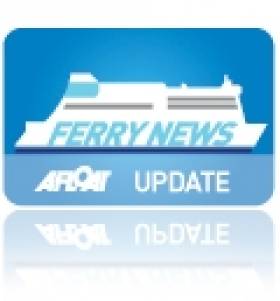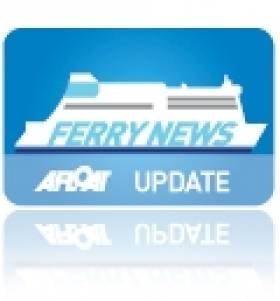Displaying items by tag: DublinHeysham
Seatruck Ferries Introduce Larger P-Class Vessel on Dublin-Heyshem Service this Sunday
#LargerSeatruckShip – Seatruck Ferries introduction of a larger P-class ro-ro freight-ferry on Dublin-Heysham route as previously reported on Afloat.ie, can now be revealed as the 110-unit Seatruck Pace that enters service this Sunday, writes Jehan Ashmore.
Seatruck Pace replaces R-class 65-unit vessel Arrow and with the launch of the larger ro-ro vessel brings increased levels of comfort for truck-drivers. Notably, single-berth cabins on the Irish Sea route between the Irish capital and Lancashire in the north-west of England.
The introduction of Seatruck Pace reaches to three of the quartet of P-class ships serving in the Irish Sea. She joins the pair that also operate from Heysham on the company's second Lancashire link to Warrenpoint.
Final member of the P-class, leadship Clipper Point, remains chartered on a North Sea service with DFDS Seaways. The third route also operated by Seatruck Ferrries is Dublin-Liverpool served by a pair of their largest fleet ships the 150 unit FGS class.
Arrow will continue to have an Irish Sea role as the vessel is to be chartered on long-term to the Isle of Man Steam Packet Company to boost freight capacity on the Heysham-Douglas route.
Another Fine Performance
#SEATRUCK NEWBUILD - With the announcement of Seatruck Ferries new Belfast-Heysham route to open in May, the company have in the meantime introduced a newbuild this week on the Dublin-Heysham route, writes Jehan Ashmore.
Seatruck Performance brings additional capacity to the route to Lancashire and becomes the third newbuild to enter the Irish Sea where her sisters are operating Dublin-Liverpool sailings.
She has a length of 142 m, breadth of 25 m and a capacity of 151 units, which is 35 more than the earlier 'P' Class ships which have shifted elsewhere on the Seatruck network.
The final fourth vessel Seatruck Precision as previously reported is currently under construction at the FGS Flensburg yard in Germany and is expected to make her debut on the Irish Sea in June.
- Seatruck Ferries
- Seatruck Performance
- Seatruck Precision
- Irish Sea freightferry market
- Irish Sea freight haulage market
- Irish Sea roadhaulage sector
- Ports and Shipping News
- DubliLiverpool
- DublinHeysham
- BelfastHeysham
- FGS
- FGS Flensburg
- HeyshamMax newbuilds
- Pclass Seatruck newbuilds
- Port of Heysham
- New Irish Sea freightferry
Seatruck Ferries Second Ro-Ro Newbuild Launched
The remaining pair are due for delivery in June 2012 from the German shipbuilder Flensburger Schiffbau-Gesellschaft (FSG) located on the Baltic Sea, close to the Danish border.
Seatruck Ferries is a division of the Danish shipping giant Clipper Group, which operates four routes in the north Irish Sea. The company offer 80 sailings per week on four routes: Dublin-Heysham, Dublin-Liverpool, Warrenpoint-Heysham and Larne- Heysham.
Seatruck to Re-Open Dublin-Heysham Route
Seatruck Ferries is to re-open the Dublin-Heysham route following the closure by DFDS Seaways of the freight-only service last month, writes Jehan Ashmore.
The first sailing of the revived route is scheduled to depart Heysham next Monday at 02.00hrs and the corresponding departure from Dublin is at 14.00hrs. Seatruck have yet to release the identity of the one-ship operated service, previously run by DFDS Anglia Seaways.
Seatruck decided to re-open the route based on strong demand and of the firm commitment to support the service from several road haulage firms.
To facilitate the additional business of the new route, Seatruck's existing use of Terminal 3 for its Dublin-Liverpool service will no longer be required. Instead all operations will be centred at Terminal 5, previously used by DFDS Seaways for their freight and passenger ferry vessels on the Heysham and Liverpool (Birkenhead) routes.
The company which is part of the Bahamas based Clipper Group Ltd (which controls 250 vessels) also operate between Warrenpoint-Heysham and Larne-Heysham. Seatruck operate an eight–strong Irish Sea fleet, which include four new vessels that were built in Spain and introduced onto two of their routes since 2008.
Lead-ship of the four 120-trailer capacity vessels, Clipper Point was followed by Clipper Panorama on the Warrenpoint route. The Clipper Pace and the final unit of the quartet, Clipper Pennant, serve on the Liverpool route. The new Dublin-Heysham route will increase the total number of all Seatruck route sailings to 80 each week.
































































